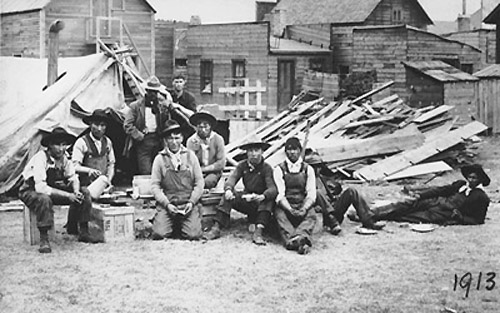![]() Construction At The Landing
Construction At The Landing

Rivermen and boatbuilders at a construction camp,
Athabasca Landing, 1913.
Provincial Archives of Alberta, Aca.33.
The steamer to be built at the Athabasca Landing this winter by the HB Co is to be 144 feet keel and 26 feet beam, a sternwheeler with engines having a 12 by 42 inch stroke. The machinery is to be furnished by the Iowa Iron Works, the same establishment which furnished that of the Grahame. The engines are of the same power as those of the same model of the Grahame. The hull of the new boat will be on much the same model as the Grahame but will be 14 ft longer with 2 ft greater breadth of beam. The machinery and supplies will be brought in the fall. The lumber will be sawn at the Landing . . . About 10 men will be employed on her all winter. It is expected to have her completed next May . . . The boat will be built on plans drawn by Capt. Smith who will superintend the work. This steamer will supply the missing link in the chain of steamboat communication reaching from Winnipeg to the Arctic Ocean, all owned and operated directly or indirectly by the HB Co, and will completely establish the northern trade by the Edmonton route. (September 24, 1887 report in the Edmonton Bulletin about building the S.S. Athabasca quoted in Athabasca Historical Society 1986, 31-32)
After we had been there for a couple of days a carload of lumber came in for the scows that had to be built to take the freight down the river. After it was unloaded we started to saw the ribs for them out. They were 2 by 4's 10 feet long and the side ones were four feet long. We put a frame up. Put a tarp on it and an air-tight heater in it to work in. As it was pretty cold we had to put a gas lantern in it as there was no power or windows for light. Getting around 50 ribs sawed, we had to nail them together, then take them outside and pile them, and start all over again.When that job was done, we started to build them. The scows were about 40 feet long, and were built upside down. The ribs were set on planks and blocks, then the bottom planks were nailed on, then the sides were done. A place where the sides met bottom, called the knuckle, had to be caulked with oakum; all the rest was done with cotton clothes line by putting it in the seams and nailing it with 1 1/2 inch nails. Tar or pitch was run in and after it was heated with a rig they had a funnel with a long handle on it and a wheel below. The wheel would push the cotton down hard, then the tar would run on top of it and harden, thus making a good water- tight seam.
After about six had been finished we had to get them out of the road as there was not enough room to build them all at once. Being upside down they had to be turned over which was done by putting an A-frame at each end. With a block and tackle they turned against the A- frame and pulled from the bottom and they just slid down onto rollers to the river. (Captain Julian Mills on the construction of scows quoted in Parker 1980, 14-15)









